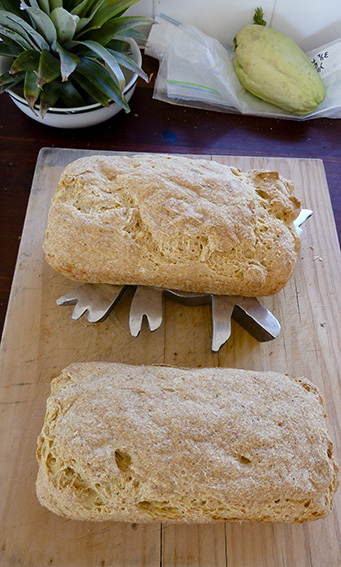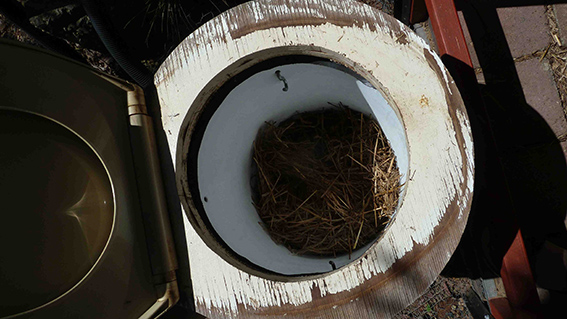This morning I was reading an update from the Evolution in Motion Team about developments at the Permaculture Demonstration Farm at Phnom Katch Phkar in Battambang Province in western Cambodia and came across a mention of the Moringa tree – also known as the Drumstick Tree, Kelor Tree (Pokok Kelor in Indonesia), and a whole lot of other names. I’d read about this tree before and been impressed by its many uses, but in thinking about species for our food forest it had completely slipped my mind.
Well, one thing led to another, as it does when you start reading something on the internet, and I came across a very useful report on the Moringa tree (scientific name Moringa oleifera) in Australia put out by Biosecurity Queensland in 2010. The report is actually a weed risk assessment of the species (they find it presents a low risk), but contains the most useful summary of information about the species that I’ve found. The report is available as a pdf file here.
I’ve taken the liberty of putting their description of the uses of Moringa (they call it the Horseradish Tree) below. There’s a full citation at the bottom of the quote, but the following is from pages 14 and 15 of Navie and Csurhes (2010).
>>Moringa oleifera has been used for such a wide variety of purposes that it has been described as a ‘miracle tree’. It is grown in many parts of the world as a ‘vegetable tree’, with the roots, leaves, flowers and fruit all being used for food (Lu & Olson 2001). The leaves are probably the most widely used part, being compared to spinach in appearance and nutritional quality (Papillo 2007). Because M. oleifera produces leaves during the dry season and during drought, it is seen as a particularly useful green vegetable in developing countries when little other food is available (Folkard & Sutherland 1996). Its leaves and pods have considerable nutritional value, yielding many vitamins and minerals (Soto 2006), and the leaves can be eaten either cooked or dried (Papillo 2007). The fruit, or ‘drumsticks’, are cooked like green beans and have a similar flavour to asparagus (HDRA 2002). In India, they are grown commercially for this purpose and are canned and exported to other parts of the world (Papillo 2007). The green seeds, which are much like peas, and the surrounding white material in the fruit can be removed from mature pods and either boiled or fried (Price 2000).
The roots have a pungent taste and are used as a substitute for horseradish, hence the common name ‘horseradish tree’. However, the root bark has to be scraped off, as it contains two alkaloids and the toxin moringinine (Price 2000). The flowers and immature fruit are used to flavour curries (Qaiser 1973) and the gum in the bark is also used to season food (HDRA 2002).
Several parts of the plant are also used in native medicines and folk remedies for the treatment of ear, eye and bronchial complaints, skin infections, fevers, stomach ulcers, diarrhoea, syphilis and nervous disorders (Qaiser 1973; Price 2000; EcoPort 2007). For example, the juice from the leaves is believed to stabilise blood pressure, the flowers are used to cure inflammations, the pods are used for joint pain, the roots are used to treat rheumatism, and the bark can be chewed as a digestive (Papillo 2007). This is just a small selection of the wide range of ailments for which M. oleifera has been promoted as an effective medicine (HDRA 2002; Fahey 2005). It has also been widely described as having antibiotic properties and being a cancer preventative (Fahey 2005). Few rigorous scientific studies have been conducted to confirm these reports; however, a compound contained in the flowers and roots, pterygospermin, has been found to have powerful antibiotic and fungicidal properties (Price 2000).
It is also highly prized as a fodder tree in developing countries, where its leaves are fed to cattle, sheep, camels, goats, pigs, poultry and donkeys (RBG Kew 1999; HDRA 2002). The branches are often lopped for fodder, and animals are also known to browse the bark and young shoots of this species (Qaiser 1973; HDRA 2002). Moringa oleifera is used as a green manure in developing countries, where it is said to significantly enrich agricultural land (Price 2000).
The wood is a good fuel for cooking and other purposes (HDRA 2002), and yields a blue dye (Duke 1983). Woodchippings can also be used to make a good quality paper (HDRA 2002). The bark can be used as an agent for tanning hides (Duke 1983; Soto 2006) and can also be beaten into a coarse fibre that can be used to make rope or mats (HDRA 2002). The viscose resin that is exuded from the bark is used in the textile industry (HDRA 2002).
The crushed leaves are also used as a domestic cleaning agent in developing countries, being employed to clean cooking utensils and even walls (HDRA 2002). Moringa oleifera also provides nectar to honey bees for a long period of the year (ICRAF 2001; HDRA 2002).
Moringa oleifera has also been employed for erosion control in areas where strong winds and long, dry spells occur simultaneously (ICRAF 2001). Because it grows very quickly it is often planted as a living fence or windbreak in developing countries (HDRA 2002; Papillo 2007). In Australia and other parts of the world it is also cultivated as an ornamental or for shade and shelter (GRIN 2007).
However, the seeds are probably the most useful part of the plant. The oil that is extracted from them, which is sometimes known as ‘ben oil’, is used for a wide variety of purposes (Qaiser 1973; Stanley 1982). They also contain a powerful flocculant, which is used for clarifying turbid water in developing countries (Lu & Olson 2001).
The seeds contain about 35–40% oil. This oil is of excellent quality, similar to olive oil, and is slow to become rancid (Price 2000). It is used as a fuel for cooking purposes and burnt for light in developing countries (HDRA 2002). It is also used in perfumes, as a lubricant in watches and other fine machinery, and for making soap (Qaiser 1973; Stanley 1982; Price 2000).
The press-cake remaining after oil extraction has been shown to retain the active ingredients for coagulation, making it a marketable commodity as a flocculant. It can be used as a quick and simple method for cleaning dirty river water in developing countries (HDRA 2002). In fact, Moringa oleifera has been compared to alum in its effectiveness at removing suspended solids from turbid water (Papillo 2007). It can also be used to harvest algae from waste water, currently an expensive process using centrifuges (Price 2000). The press-cake also contains high levels of protein and makes and excellent stockfeed or a good fertiliser for use in agriculture (HDRA 2002; Brockman 2007).
In Australia, and other parts of the world, the greatest potential for this species is currently thought to be in its cultivation for the production of biofuel. Yields of about 10 metric tonnes of pods per hectare per year are thought to be achievable for this species (Duke 1983). It has been suggested that this would equate to between 1000 and 2000 litres of biodiesel per hectare per annum (Brockman 2007). Very high yields of oil have already been produced in overseas situations, but it has not yet been widely trialled in Australia (O’Connell et al. 2007). However, trials were recently initiated in south-western Western Australia and at Carnarvon, and are also planned for the Pilbarra region (Low a& Booth 2007; SWCC 2007).
It is particularly desirable because it is a very low water-use crop and may be cultivated on marginal land (i.e. in semi-arid areas, on poor soils and in saline areas) (Soto 2006; Brockman 2007; SWCC 2007). Moringa oleifera is being grown commercially on at least one farm at Bowen in northern Queensland. The vegetable products of this crop are being supplied to consumers in southern Australia, no doubt largely those from expatriate Asian communities (Soto 2006). Production of these vegetable products in this region is about 35 tonnes per hectare per year (Soto 2006).
In other parts of the world, Moringa oleifera is most commonly and quickly cultivated by cuttings. Ideally, these should be taken from healthy branches containing hard wood in the rainy season and be between 0.5 and 2 m in length (HDRA 2002). Frequent pruning of the growth tips of cultivated plants will maintain and increase leaf growth and control the height of the tree, making harvesting of the leaves and fruit easier (HDRA 2002).<< Source: Navie, S. and S. Csurhes (2010). Weed Risk Assessment – Horseradish Tree, Moringa oleifera. Biosecurity Queensland, Brisbane. pp.14-15. The references for the publications cited above are in the report here.

Seeds of Moringa oleifera (photo: Aravind Sivaraj, Creative Commons Share Alike)
Some Useful Links
Wikipedia entry: http://en.wikipedia.org/wiki/Moringa_oleifera
Gallery of photos (Indonesian): http://ms.wikipedia.org/wiki/Pokok_Kelor
Gardening Australia Factsheet: http://www.abc.net.au/gardening/stories/s1345822.htm
Growing and cooking tips: http://www.daleysfruit.com.au/Herbs/horseradish.htm
Additional information: http://www.newcrops.uq.edu.au/newslett/ncnl9192.htm
A really good slideshow: http://www.treesforlife.org/sites/default/files/documents/Moringa%20Presentation%20%28General%29%20screen.pdf
Overview facts: http://www.treesforlife.org/our-work/our-initiatives/moringa














